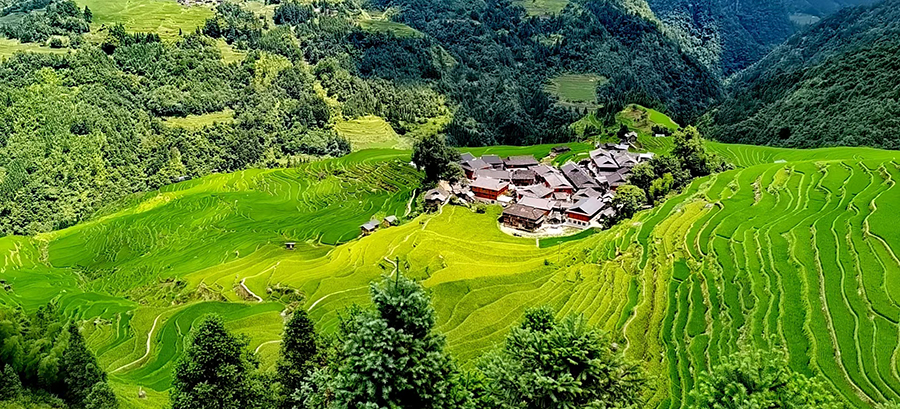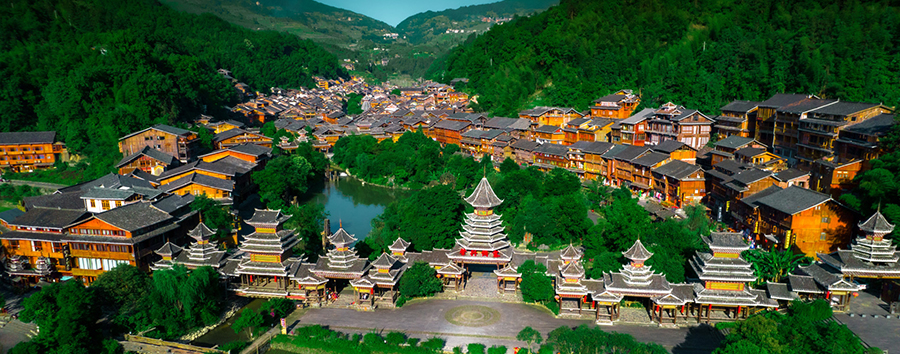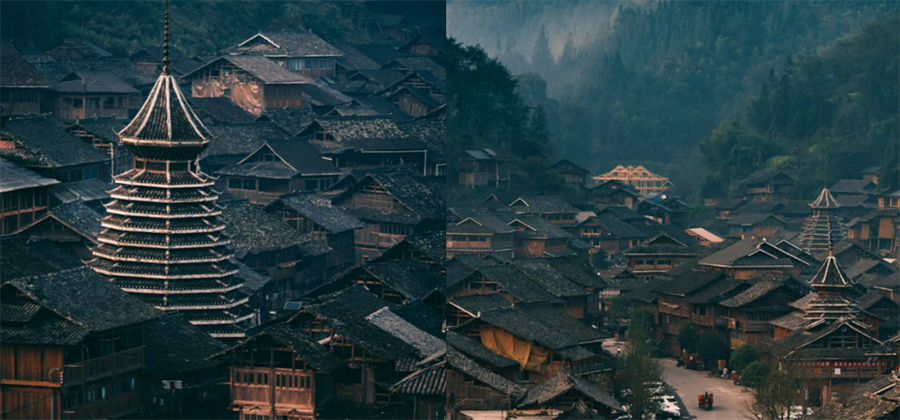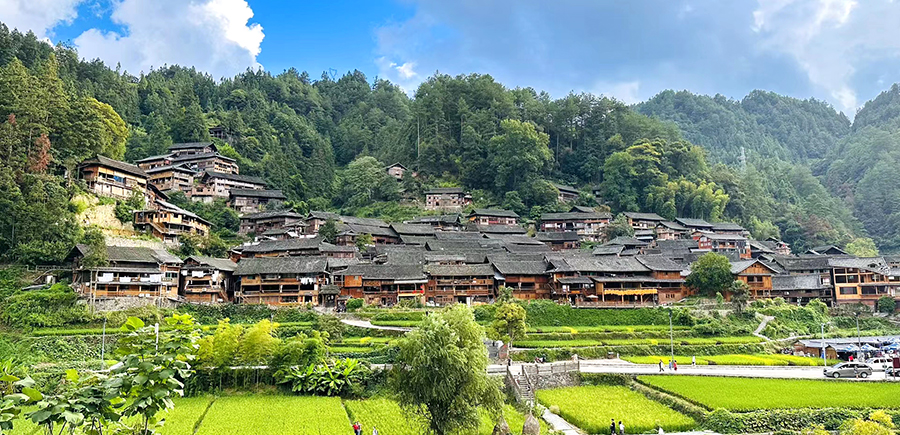- XML
- Sitemap
- Email: guizhoutravel@hotmail.com
- ABOUT US
- CONTACT US



7 Days Guizhou In-Depth Ethnic Tours with Jiabang Terraced Fields
Description

Day 1 Congjiang Arrival & Transfer to Zhaoxing Dong Village
Pick up at Congjiang Railway Station - Zhaoxing Dong Village
Welcome to Congjiang and Zhaoxing!
Upon arrival at Congjiang Railway Station, the local guide and driver will meet you at the arrival hall of the train station. Then, they will transfer you to Zhaoxing Dong Village, the largest Dong village in Guizhou.


After checking in to your hotel, you‘ll start to explore Zhaoxing Dong Village. It has been selected as “one of the six most beautiful countryside in China” and together with its drum towers were listed into the Guinness World Records in 2001. It is divided into 5 natural small villages, living in five different areas - which are called “Tuan” locally. Besides, there are five drum towers, five Wind and Rain Bridges and five stages setting in the village. Start your exploration from the village gate and get atop of the viewing platform to enjoy the panorama, where you can also clearly appreciate the five drum towers standing beautifully in the village. Afterwards, pay a visit to the Zhaoxing Dong Culture Museum to have a better understanding about Dong people and its culture in all aspects. Follow the route to visit Xin Tuan (means faith) with the highest drum tower at 25.9 meters, Zhi Tuan (means wisdom), Yi Tuan (means righteousness), Li Tuan (means Rritual) with the first drum tower in Zhaoxing built in 17th century and Ren Tuan (means benevolence). If weather permits, watch the famous Grand Song of Dong People and other interesting programs.
Arrival Ideas: High speed trains are well connected Congjiang with Guiyang (1.5-2hrs), Guilin (about 1hr), Yangshuo (1-1.5hrs), Guangzhou (3.5-4 hours), Chengdu (about 5hrs), Chongqing (3.5-4hrs) and more destinations. Congjiang Railway Station is about 6.5 kilometers from Zhaoxing Dong Village which needs about 20 minutes‘ drive.
Day 2 Zhaoxing - Congjiang - Jiabang Rice Terraces (B, L)
Huanggang Dong Village - Biasha Miao Village - Jiabang Rice Terraces.


In this morning, you‘ll catch the best time to visit Jiabang Rice Terrace. Jiabang Rice Terrace, cultivated by the Miao people, is one of the most beautiful and the most mysterious rice terrace in China. It is composed of 10,000 acres, scattered in Dangniu, Jiaye, Jiaju, Congkai, Pingyin, Jiabang, Baibei and Baidang villages. Every morning, when the cloud and mist rise above the river and field, Jiabang Rice Terrace become a fairyland on earth. Start your visit from Dangniu Rice Terrace where you can see the rice terrace layer upon layer stretching from the valley to the hill, walk a little to Jiaya Rice Terrace with beautiful curves; move another 2 kilometers to Jiache Village and catch the best panorama at the viewing platform, and visit the magnificent Yangsongling Rice Terrace to view the screw terrace. (Note: Go April to early May for mirror-like irrigated terrace and rice transplanting scene; go in May for clouds with mists scene, go from May to mid-September for green terraces; go late September to early-October for golden and harvest scene.)
Overnight in Jiaju Village
Day3 Jiaju Village-Donglang-Dali-Rongjiang(B, L)
Jiaju-Donglang-Dali Dong village
Jiaju-Donglang-Dali Dong village
After the rice terrace viewing, drive to Dali Dong Village near Rongjiang County. On the way to Dali, we will explore the remote and far Miao villages on Mountain Moon(Yueliangshan mountain).


Dali Village is a quiet village with 400 ancient phoebes and over 40 are with a history over 500 years. Once you enter into the village through Wind and Rain Bridges, you’ll step on the ancient stone-paved path built in the reign of Qianlong in Qing Dynasty (1636-1912). All the buildings are built from wood and the most common of which are built as quadrangle dwellings. Don’t miss Yang Family Quadrangle Courtyard with over 200 years with 93 generations living here. Come to the center of the village to see the drum tower. And if you are lucky, enjoy the performances held at the square. If time permits, you can do a little hiking to the beautiful Sandie Waterfall about 2 kilometers away.
After the tour, be escorted to Rongjiang County for accommodation.
Overnight in Rongjiang
Day4 Rongjiang - Kaili -Wudong(B, L)
Kala-Shiqiao village-Upper Langde Miao village-Transfer to Wudong
Today you will travel from Rongjiang to Wudong village via Kaili, the cultural center of Guizhou’s Qiandongnan ethnic region. It is a scenic drive around 180km/3 hours with a leisure pace. En route, stop at the Viewing Plaform to enjoy the panoramic landscape of Gaoyao Rice Terrace where over a thousand acres of terraced fields sitting atop a majestic mountain, cascading layer upon layer, stretching all the way from the mountain peak to its base while a beautiful Miao village resting quietly on the terraces. You will then go to Shiqiao Village which is famous for the national intangible cultural heritage of traditional paper making with trees’ bark by Miao ethnic group. Catch the rare opportunity to see the traditional processes of making papers in the Chuandong, a natural cave where the underground river water flows quietly. Recommended optional activity: learn to make Flower Paper in the craftshop of a local family.

The final attraction for today is Upper Langde Miao Village, renowned as "the Hometown of Chinese Folk Song and Dance Art," located approximately 28 kilometers away from Kaili. This charming village offers a refreshing escape from bustling crowds, embracing a tranquil natural ambiance while welcoming visitors with open arms and showcasing its rich cultural heritage. Upon reaching the village, you will be greeted with genuine warmth through a traditional welcome ceremony with the lovely ladies and girls, elegantly adorned in traditional Miao costumes offering "block-the-way" wine. Allow the flavors of the wine to delight your senses while immersing yourself in the genuine hospitality of the villagers. Following the convivial toasts, immerse yourself further in the vibrant atmosphere as you witness an enthralling singing and dancing performance at the Lusheng Ground. Here, the talented men of the village will skillfully play the Lusheng, a traditional musical instrument, while the graceful ladies showcase their artistry through mesmerizing dances. Should you wish, feel free to join in the dance. To enrich your experience, you can take part in the village’s Cultural Program which usually includes catching fish in the field, picking fresh vegetable in the farm and learning to make embroidery. If you want to experience this Cultural Program, please tell your travel consultant in advance to make appointment.
Accommodate in Wudong village which is about 35km from Upper Langde Miao Village.
Overnight in Wudong Miao Village
Day5 Wudong - Zhenyuan Ancient Town (B, L)
Wudong village-Zhenyuan Ancient town-Black Dragon Cave
Later, you’ll be escorted to Zhenyuan Ancient Town (about 140 km from Wudong Village, for 2 hours‘ driving). With a history of more than 2,200 years, Zhenyuan Ancient Town features hundreds of ancient buildings in Ming (1368-1644) and Qing (1644-1912) Dynasties. After arriving at Zhenyuan Ancient Town, you will go to explore Black Dragon Cave (also called Qinglong Cave). This is not simply a cave, but a ancient architectural complex of ancient temples, pavilions, shrines and palaces standing on Zhonghe Mountain. It well presents the Buddhism, Taoism and Confucianism culture with the magnificent construction and layout. It is said that Zhang Sanfeng, the founder of Tai Chi, personally selected and involved in the construction of the temples. This scenic spot is composed of the following parts including the Zhusheng Bridge, Zhongyuan Temple, Ziyang Shuyuan (Academy of Classical Learning), Jade Emperor Pavilion, Longevity Palace and Xianglu Yan. After getting to the top of the cave, catch the appealing panorama of Zhenyuan Ancient Town and Wuyang River in charm and peace. The visit will be truly a cultural highlight during your Zhenyuan trip.

Have a good sleep in the ancient town tonight.
Optional activity: taking a scenic boat sailing leisurely on Wuyang River to enjoy the dazzling night scene with numerous stone buildings by the river.
Day6 Zhenyuan-Kaili(B, L)
Zhenyuan Ancient town-Wuyang river-Matang
After breakfast, you‘ll take a peaceful walk in Zhenyuan Ancient Town. The mother river called Wuyang River passes through the town in the shape of “S”, making the whole town look like Eight Diagrams and Zhenyuan is also reputed as “Oriental Venice”. Go to visit Tin Hau Temple in the architectural style of Southern Fujian. This temple has witnessed the flourishing period of Wuyang River waterway. Walk to Zhenjiang Pavilion which was built in Ming Dynasty situated in the west of the town. Have a nice stroll along the old alleys to appreciate traditional folk houses and the ancient wells. You won’t miss Sifangjing Alley.
After your walk in Zhenyuan, we can drive about 120 km (about 2 hour) to Matang Gejia Village, a primitive Miao village with over 400 Gejia people who are called the 57 th ethnic group in China unofficially. According to the legend, Gejia people are the direct descendants of Hou Yi, a legendary hero who was said to shoot the nine scorching suns in order to save his people. Matang Village is famous for exotic attires, colorful festivals and countryside feelings. The women and girls here are specialized in batik that you can fully appreciate the uniqueness of the Gejia batik patterns and embroidery as well as the excellent craftsmanship of the villagers. If you are interested, you can learn how to make batik with wax from a local master and create your own batik work (optional experience with extra payment).
Overnight in Kaili
Day7 Kaili-Guiyang(B)
You have two options today, you can go to Guiyang airport for your flight or take a bullet train at Kaili Nan railway station for your next destination.
CONTACT US
-
- Mobile: +86 13595521025
- Email: guizhoutravel@hotmail.com
- ADD: No.53, East Yingpan Road, Kaili city, Guizhou province, China


 Bill ZHANG
Bill ZHANG